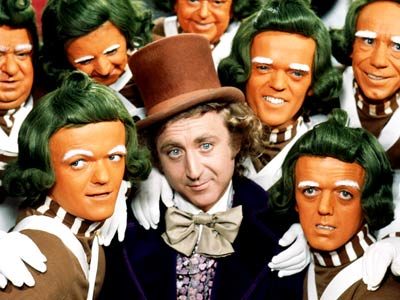Chocolate Protects Against High Blood Pressure, Stroke
Willy Wonka may have been on the right track — chocolate may be a sweet way to control blood pressure and thus protect the heart, according to a report from German researchers.

Nutrition Notes
Dark chocolate, like red grapes, blueberries and black and green tea, is packed with flavonoids, phytochemicals with antioxidant, anti-inflammatory and anti-clotting properties. Numerous studies have hinted that dark chocolate may play a role in a heart health by lowering blood pressure and reducing cholesterol levels.
In 2005, Italian researchers made headlines when they found that 100 grams of dark chocolate per day lowered blood pressure and reduce LDL (“bad”) cholesterol levels. Two years later, German researchers found that just 6.3 grams, or 30 calories worth, of dark chocolate per day was sufficient to reduce blood pressure.
In 2010, a European study of more than 19,000 adults found that those who ate the most dark chocolate per day – about 7.5 grams (or one square of a 100 gram bar) – had lower blood pressure and were 39 percent less likely to have a heart attack or stroke, compared to people who ate the least amount of chocolate.
The health benefits of chocolate are limited to dark chocolate, which is rich in flavonoids. Dark chocolate has approximately four times as many flavonoids as milk chocolate, while white chocolate has none. To maximize dark chocolate’s heart health benefits, choose a dark chocolate bar with at least 70 percent cocoa content. The greater the percentage of cocoa solids in chocolate, the more flavonoids are present.
While dark chocolate’s health benefits are mounting, keep in mind that chocolate is a source of calories, fat and sugar. Keep your portion size small: about 30 grams or 1 ounce.
[youtube]http://youtu.be/LcAGqMHVh5Y[/youtube]
Nutrient information per 30 grams (1 ounce) dark chocolate:
| Calories | 182 cal |
| Fat | 13 g |
| Saturated fat | 7 g |
| Protein | 2 g |
| Carbohydrate | 14 g |
| Fibre | 3.3 g |
| Caffeine | 24 mg |
Source: Canadian Nutrient File, 2007b
Varieties
Dark chocolate can either be sweet, semi-sweet, bittersweet or unsweetened.
Sweet dark chocolate
Compared to other types of dark chocolate, sweet dark chocolate typically contains the least amount of cocoa solids, usually 35 to 45%. It tastes similar to semi-sweet chocolate.
Semi-sweet chocolate
This classic dark baking chocolate can be purchased in most grocery stores. It’s often used for cakes, cookies and brownies. It has a good, sweet flavor and typically contains between 40 and 62% cocoa solids.
Bittersweet chocolate
Good quality bittersweet chocolate contains between 60 and 85% cocoa solids. If the content of cocoa solids is high, bittersweet dark chocolate has a rich, intense and bitter chocolate flavor.
Unsweetened chocolate
Unsweetened dark chocolate is too bitter to be eaten on its own, and is most often used in baking. Unsweetened chocolate can contain up to 100% cocoa solids.
Buying
The quality of chocolate depends both on the quality of the raw ingredients and how they’ve been processed. Both the cocoa butter content and the price of dark chocolate are usualy indicators of quality.
Read the ingredient list of dark chocolate to make sure that you are buying real chocolate with at least 70 percent cocoa solids. Not all chocolate labelled “dark” contains at least 70 percent cocoa.
Good quality dark chocolate should be shiny and free of lumps, bubbles and white specks. Avoid chocolate that is discoloured, grey, dull or crystallized, as these are an indication that the chocolate is old or has been improperly stored.
Storing
For maximum freshness, wrap opened chocolate in aluminum foil and then again in plastic and store it in a dry, cool place. Properly stored dark chocolate will stay fresh for up to one year. Chocolate is best stored between 20° and 22° C, such as a pantry, or dark cabinet. Avoid storing chocolate in the refrigerator.
Sometimes chocolate will “bloom”, which is characterized by white or gray “clouds” or “blooms” on its surface, a grey, streaky, dull finish on the surface and a crumbly texture. Bloom is caused by moisture or temperature fluctuations, but does not mean the chocolate is spoiled. Melted for recipes, it behaves and tastes like any other melted chocolate.
You can freeze chocolate, but it is more likely to bloom, so it is best used in baked goods. Before using frozen chocolate, thaw completely in the refrigerator without removing it from the bag. This will prevent condensation, which will damage the chocolate.
Chocolate easily absorbs odors, so make sure to store it away from any items that might impart strong aromas.
Preparing
There a number of ways dark chocolate can be prepared, depending on how it is going to be used.
Melting: Place finely chopped dark chcoclate in a bowl over a pan of warm water and stir until melted. Be careful not to get any water in the bowl, as this will cause the chocolate to seize and become solid. To melt chocolate in the microwave, place chocolate in a microwave-safe bowl and heat at 50 percent power. Stir the chocolate several times when melting in the microwave to prevent burning.
Once melted, keep chocolate in a bowl over a pan of warm water to prevent it from solidifying.
Chocolate Curls: Chocolate curls are an elegant way to add chocolate to desserts. To make chocolate curls, use a vegetable peeler to slice curls from a block of chocolate. Alternatively, melt chopped chocolate, pour it onto a flat surface and spread to a thin, even thickness. Let cool. Scrape chocolate off with a very sharp butcher’s knife or a wide metal spatula.
Eating
If you’re like most people, you probable don’t need any ideas of how to add dark chocolate to your diet! Good quality dark chocolate is delicious when eaten on its own, but it’s also a wonderful addition to cookies, loaves, pancakes and muffins. Dark chocolate is also the perfect accompaniment to fresh fruit.
Healthy ways to enjoy:
Breakfast
- Toss unsweetened dark chocolate chips into pancake or waffle batter for special treat.
- Sprinkle dark chocolate chunks and dried cranberries over warm oatmeal for a flavourful breakfast.
Lunch
- Enjoy a small square of dark chocolate after lunch to help curb cravings for sweets later in the day.
- Treat yourself to a warm cup of hot cocoa for a satisfying dessert.
Dinner
- Add a small amount of dark chocolate to a pot of chili – it adds a surprisingly rich and complex flavor.
Snacks
- Dip strawberries and slices of fresh fruit (e.g. pear, apple and melon) in melted dark chocolate for a heart healthy mid-afternoon snack or dessert. Get a recipe!
- Add unsweetened dark chocolate chunks to muffins, cookies and loaf batters.
- Add semisweet dark chocolate chips to homemade trail mix and granola.
Did you know?
- Cocoa, the main ingredient in chocolate, has been cultivated for at least three thousand years in Mexico, Central and South America, with its earliest documented use around 1100 BC.
- Roughly two-thirds of the entire world’s cocoa is produced in Western Africa.
- The Hershey Company is the largest chocolate manufacturer in North America.
- http://www.lesliebeck.com/foods/dark_chocolate





 Hi I’m Catherine, founder of Wine Women And Chocolate. Want to become a contributor for Wine, Women & Chocolate? Interested in sharing your unique perspective to a group of supportive, like-minded women?
Hi I’m Catherine, founder of Wine Women And Chocolate. Want to become a contributor for Wine, Women & Chocolate? Interested in sharing your unique perspective to a group of supportive, like-minded women?